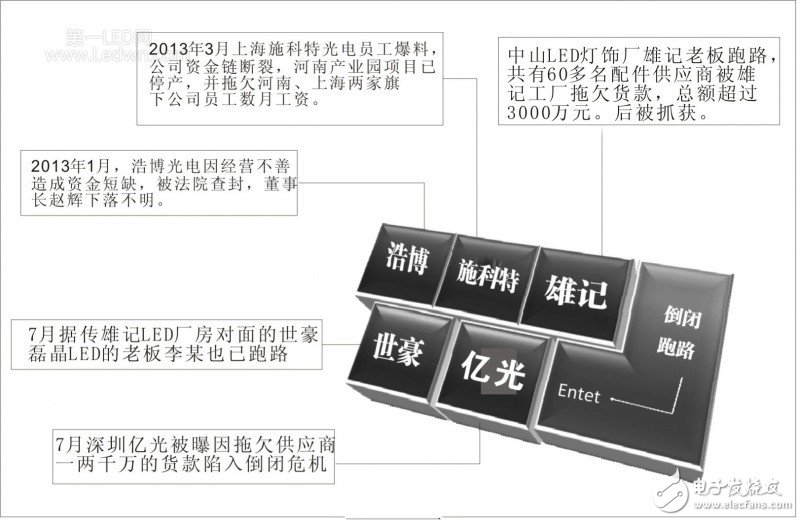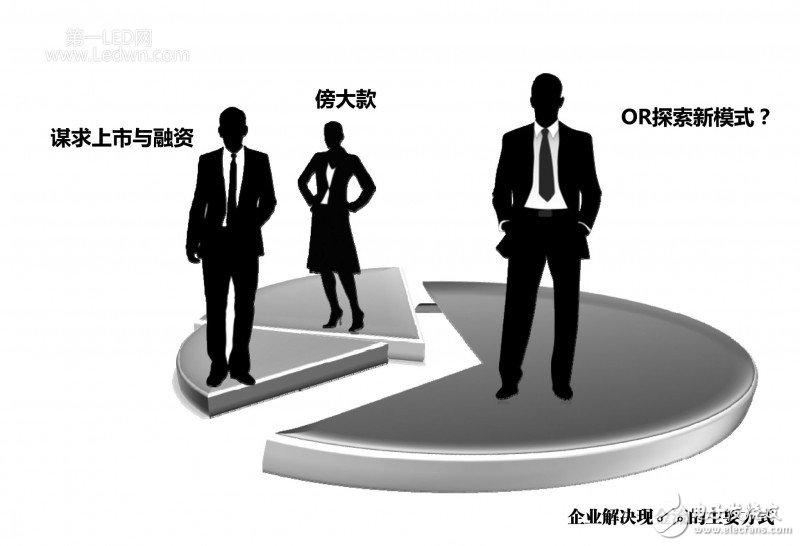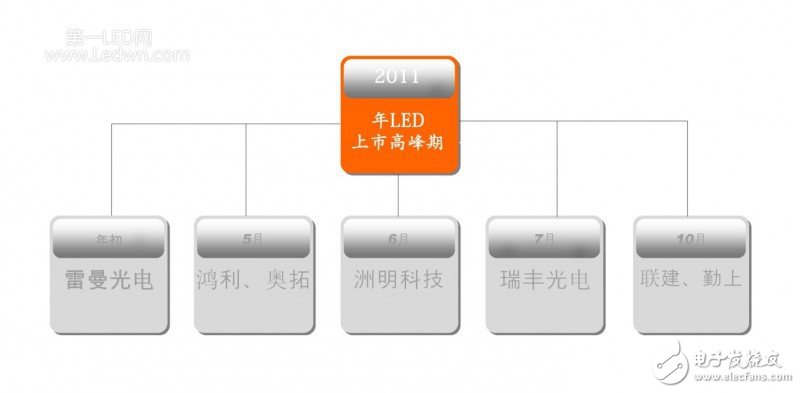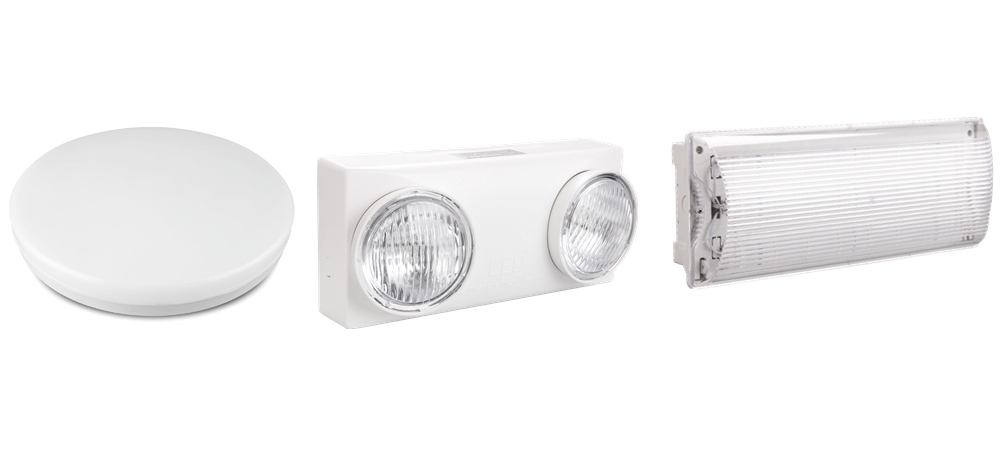1. Industry inferiority-the ups and downs of government policy
An industry developed under the government's impetus will inevitably have inherent deficiencies. After the LED industry was pulled into a key development project by the government ten years ago, various industrial parks have sprung up and the development trend is like a bamboo shoot. But after ten years, when we look back at the industry At that time, although the achievements were great, but the problem was not small, if the government did not intervene in the industry, then I think today's LED industry may be another situation.
Today, when the government began to reflect on this industry, many of our companies were uneasy. This is a performance of several times of self-confidence, and it is also the industry's lack of confidence under the government's push. Take Guangdong as an example. Guangdong is the largest province that actively promotes the development of the industry. Guangdong has a strong support for the development of the LED industry. There are few people in the country, but this has also caused much controversy while stimulating Guangdong to become an LED leader. Data show that in 2012, Guangdong LED output value reached 150 billion yuan, accounting for more than 70% of the country's 205.9 billion yuan over the same period. At present, there are more than 6,000 LED enterprises in Guangdong Province. However, Guangdong still has no core competitiveness in terms of LED. The LED industry has brought serious pressure on production capacity, and the events that really triggered the industry ’s lack of confidence are manifested in two things. One is Shenzhen, which occupies half of Guangdong ’s LED. In March this year, a government bulletin was issued to abolish the "Notice on Printing and Distributing the Shenzhen LED Industry Development Plan (2009-2015)" issued in 2009. Although Shenzhen has denied denying the LED industry several times, Shenzhen still has no substantive support policies. Second, Li Xinghua, secretary of the party group and director of the Guangdong Provincial Department of Science and Technology, accepted the organization on suspicion of serious disciplinary violations. After these two incidents occurred, the industry was active, and an industry was so "pan-politicized" that it was so serious that it was deeply criticized and how unconfident it was.
In addition, the dark tide of government subsidies has caused many enterprises in the industry to hate and love, but not to stop. Obtaining subsidies is one of the fastest and best ways for enterprises to solve the cash flow problem, but behind the subsidies it creates unfairness in the enterprise, which inevitably leads to corruption and backdoors. Logically speaking, the mature industry is regulated by the market, but the LED industry still seems to be an important industry in the eyes of the government, so the government believes that appropriate regulation is necessary. But what LED ultimately has to do is to abandon the government's marketization.
2. Industry turmoil-business failure
After several years of singing all the way, the sequelae of the LED industry continue to emerge, and the shuffle period continues. At present, the industry has both turbulence and development, and its main theme is still development, but the turmoil is quite obvious during this period. Failure, running, integration and reorganization have become the current main theme. The following picture shows the representative companies that have fallen since this year.

Falling like a grand plan is completely a victim of a low-end price war. In a disorderly competitive environment where there is no lower and only the lowest, the price is actually the cash flow. According to the supplier, the price of the lamps started by Xiong Kee is still Slightly rational, taking the 3W led bulb as an example, the price is about 5 yuan, and the price is still a little profit, but later, the price of Xiong Kee is only 3.8 yuan. The suppliers add up, and this price cannot even make up for the cost. This is also one of the chaos in the industry. The same product has a gap of 3 yuan to 300 yuan. This is an extremely unreasonable industry phenomenon. For example, Haobo and Shenzhen Yiguang used to be leaders in the display industry, but the collapse was caused by the collapse of a sudden collapse, which was ultimately caused by critical cash flow problems. The apparent problem of Shanghai Schott is excessive expansion. In short, the most non-cash flow is the core reason for the failure of the company.
3. Corporate panic-bank warning to cut off the capital chain
It is reported that due to the overcapacity of the Guangdong LED industry and the closure of some enterprises, a state-owned large bank, the Guangdong Branch, has issued an emergency notice that reads: "In recent years, the LED industry has experienced rapid growth in investment, overcapacity has become prominent, and systemic risks have emerged. At the same time, each sub-branch and other branches are required to conduct stock credit customers involved in the LED industry, and require that details, credit conditions and proposed measures for risk response be reported before August 2. It is understood that other banks have also noticed the related risks, and gave risk warnings to their sub-branches and account managers, intending to tighten credit and credit, and debt collection. This will undoubtedly worsen the LED enterprises, and even a fatal blow. The bank's suspicion of poverty and love for the rich also manifested itself nakedly. China has always been a small and medium-sized enterprise because of its low efficiency, high risk, and low corporate integrity. Therefore, many banks are reluctant to give small or medium-sized loans to small and medium-sized enterprises. But for enterprises to develop, capital is an indispensable "blood". Enterprises have to turn their attention to private financing, obtain liquidity by means of mortgages, mutual guarantees, high-profit loans, etc., and gradually build an extremely complex capital network. The financing leverage is amplified. If one of the links fails, it will trigger chain reaction. So that the development of enterprises is at a loss. Such warnings by banks will inevitably cause some LED companies to be "sincere and fearful" and "lack of money if they are thirsty", prompting soaring private interest rates, and enterprises are caught in the dilemma of "no way to make blood, no way to transfusion".
The road to self-rescue of led enterprises-the main way to solve cash flow
"Lack of money" severely restricts the development capabilities of enterprises. At present, because the real civilian market of led lighting has not been opened, some companies are not realistic in obtaining cash flow from the city. In addition, due to the particularity of the payment method and cycle of the manufacturing industry Decided that the company must keep enough cash flow as operating capital, which is particularly important for the LED display industry. Several failed display manufacturers should cause the capital chain to break for this reason. One side is the supplier's dunning and the other is The contractor's delay in payment, coupled with the company's employees' salary, at this time, if the company's cash flow is insufficient, the company is bound to go to the end without external capital injection. Then we also see the efforts of LED companies in solving the problem of "money". To sum up, there are mainly several ways.

1. Seeking to go public
Going public is a dream that many companies dream of, so that they can not only make the company bigger and stronger, but more importantly, solve the capital problem of enterprise development. But seeking to go public can be said to be a way for "rich and handsome" enterprises. The intensive listing boom that LED-related companies started in 2011 is also the peak period for LED listing.

In 2012, there were 6 LED companies that were successfully listed in the first quarter alone, including Wanrun Technology (February 17), Liad (March 15), Moso Power (March 16), and Jufei Optoelectronics (March 19), Rectangular Lighting (March 21), and Yuanfang Optoelectronics (March 29), it is not difficult to see that there are 5 companies all listed in March. Huacan Optoelectronics was successfully listed on June 1. In 2013, this trend slowed down, of course, also related to the increase of the SFC threshold.
Although listing is a relatively direct way to obtain funding, it is precisely because of this that some companies have resorted to any means for listing. This has led to the emergence of a number of diseased listed companies. Being questioned by the media has put tremendous pressure on corporate public relations, and more seriously, it has dampened the confidence of investors and investors. If it is really listed with disease, then you should try to improve yourself in the follow-up operation. Of course, obtaining cash flow through listing is not so easy, nor is it a popular way. Dalian Lumei failed to get an IPO for three consecutive years, so that it is currently in a restructuring stage; Shanghai Lanbao wants to backdoor listing so that it ca n’t help itself today.
2. Sugar daddy
Recently, "Sunda Money" is more popular in the industry, and it also reflects from the side that companies are really "lack of money". Everyone's life is really hard, especially in the display industry. After Furi Electronics, Lianteng found Jiangmen Keheng Co., Ltd., Lei Di Pang Shangzhou Ming and so on. In the upstream field, Suzhou Xinnajing won the full support of employer Xinhaiyi, and Xu Rui bumped into Guoxing.
Compared to running the road, closing down, and dissolving, in general "sugar money" is a living road, not only can get cash flow to solve the urgent need, but also can allow enterprises to stay in Qingshan to make a comeback. In the second half of this year, this trend is developing brightly. Furi Electronics announced that it intends to issue no more than 50 million shares to specific investors at a price of 6.41 yuan per share. The raised funds will be mainly used to acquire 92.80% of the registered capital of Marui Optoelectronics. (34.15 million yuan), and supplementary working capital. According to the latest announcement, Furi Electronics will convene a shareholders' meeting on September 2 to consider proposals such as a fixed increase and the transfer of 92.8% equity in Mairui Optoelectronics. It is reported that if everything goes well, the acquisition of Marui Optoelectronics will be completed in September of this year, and it can be consolidated in the fourth quarter. Furi Electronics also stated that from 2013 to 2015, it will provide financial support of not less than 10% of Marui's previous year's sales revenue each year to improve acquisition synergy. Lianteng Technology is similar to Marui Optoelectronics. On the evening of July 30, Keheng shares issued an announcement that in order to further improve the company's layout in the LED industry chain and quickly enter the field of LED product application terminals, the company decided to acquire Shenzhen Lianteng Technology Co., Ltd. with its own funds of 10.95 million yuan. 51% of the shares, and is responsible for raising liquidity from Lianteng Technology with a total amount not exceeding 20 million yuan.
3. New OTC model
It is understood that the Qianhai Equity Exchange Center was established in May 2012 based on huge market demand. Its shareholders are mostly composed of securities companies and venture capital institutions. In addition, the integration of the exchange center with the Shenzhen Stock Exchange is conducive to those with good growth. 1. A listed company with strong profitability will enter the A-share market in the future. The OTC model provides a simpler and more convenient financing model for the majority of SMEs, and at the same time provides a basis for them to achieve the pace of going public. There is no cost for an enterprise to apply for listing on Qianhai OTC, as long as it meets the accumulated net profit of not less than 3 million yuan in the last 12 months; the accumulated operating income of not less than 20 million yuan in the last 12 months; or the last 24 Cumulative monthly operating income is not less than 20 million yuan, and the growth rate is not less than 30%; net assets are not less than 10 million yuan, and the operating income in the last 12 months is not less than 5 million yuan; bank loans in the last 12 months It can be applied if it reaches more than 1 million yuan or one of the four conditions of investment institution equity investment.
At the end of July, Shenzhen Colent Qianhai Equity Exchange Center (OTC) was successfully listed and became the first batch of OTC listed LED companies. In addition to Colente, Shenzhen Huagao Optoelectronics Technology Co., Ltd., Shenzhen Minbao Optoelectronics Technology Co., Ltd., Shenzhen Lianteng Technology Co., Ltd. and other companies have also successfully listed on OTC.
For LED small and medium-sized enterprises, where can we raise useful funds, and which financing methods can help companies to develop smoothly are worth trying. Qianhai Equity Exchange Center is a regional trading market of state-owned enterprise holding and market-oriented operation built in Shenzhen Qianhai Shenzhen-Hong Kong Modern Service Industry Cooperation Zone. As the core organization of the regional equity exchange market in Guangdong Province, Qianhai Equity Exchange Center The goal is to create a new market-oriented financing platform for SMEs that is independent of the Shanghai and Shenzhen Stock Exchanges and commercial banks, and to build an "online tribe" that is open, interactive, reciprocal and win-win for investors and enterprises , Use the new Internet technology to provide the best communication method for investment and financing parties, to achieve direct dialogue, pricing and transactions between investors and enterprises. However, it is worth noting that the OTC model is also not perfect. It is understood that due to the low requirements for enterprises in the OTC market, the enterprises in the OTC market are uneven, filled with a few junk stocks and empty shells. Enterprises in the OTC market are not 100% favored by institutional investors. About 50% of stocks basically have no trading volume, and the refinancing function is weak.
Led Emergency Light have been divided into two heads emergency lights , bulkhead emergency lights , emergency ceiling lights and emergency bulbs . The role of emergency lights is an emergency state evacuating people , generally used in public places . All emergency lights use LED source , its advantages are high brightness , low power consumption , LED lighting effect than the traditional light source energy saving nearly 80% .

Led Emergency Light,Rechargeable Emergency Lighting,Recessed Emergency Light,Automatic Emergency Light
Jiangmen City Pengjiang District Qihui Lighting Electrical Appliances Co., Ltd , https://www.qihuilights.com